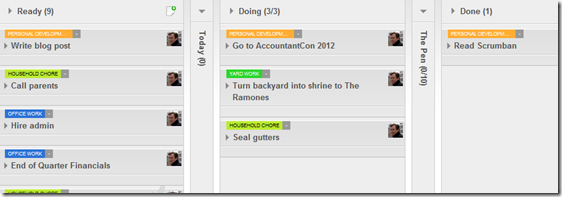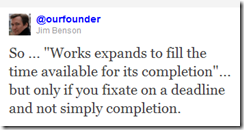Scooter Reduces Cycle Time to Rowlf’s Breaking Point
Here we find Rowlf singing Coleman and Fields’ “It’s Not Where You Start, It’s Where You Finish.” He sings at a comfortable rate and all is well. Scooter then tells him he needs to do it again, but this time a little faster. So Rowlf turns on the juice, hits more of a ragtime vibe, and blasts through the song, completing with a bit of stress, but still can add a flourish or two on the piano. Scooter then pokes his head in and tells him to do it again in 20 seconds. Rowlf then shifts into high gear, his ears flapping, his head bouncing, and words coming out fast enough to rival hardcore 80s punk. At the end of the third, he's done his work in such a short amount of time, he must close the piano all together and simply concentrate on breathing.In our work, we have lean concepts of flow, cadence, and slack. In our book, Personal Kanban, we describe them like this:
Flow: The natural progress of work
Cadence: The predictable and regular elements of work
Slack: The gaps between work that make flow possible and define cadence
Flow is a little deeper than this, because the concept of “flow” differs slightly for psychologists or lean practitioners. Both concepts, however, are important for knowledge workers and managers.For psychologists, “flow” is a state of mind where we feel in the zone. This is where everything is moving at the right pace, we have clarity and comfort with our actions, and we have a sense of peace with the process under which we are working.In lean, “flow” is more the rate at which work progresses. You have a value stream and work flows along it. Flow is hindered by bottlenecks, constraints, policies, or other ne’er-do-wells.Cadence helps us set flow. It’s like the beat. It’s the rhythm of our work. The right cadence can move tasks from start to completion at just the right rate to maximize completion and quality.Slack is sort of the space between beats. You can’t have a drum solo without silence.All three of these work together to create a natural system of work not unlike music. So we see it in Rowlf.The first round of the song he is fine, even the request for a faster variation is welcome. He can complete his task and is ready for more.The second round of the song, he makes little jokes like, “how’m I doing?!” He’s going faster than he’s comfortable with, his pace is not sustainable, but he can still complete the work. (This unsustainable fast pace is where many companies try to keep their knowledge workers).The third round is where some misguided managers like to live every day. Rowlf is asked to do the song at the very limits of his capability: in 30 seconds. Scooter, the project manager, isn’t even listening to the song, he’s just counting the seconds to on-time completion. Rowlf does bring the project in on-time but, again, he completely collapses after it is done.Between the first and third rounds, Rowlf endures a great deal of stress. When flow, cadence, and slack are in agreement, product delivery is flawless and nearly effortless. The more they are not in agreement, the more effort is needed and the more stressful the work is.At his initial pace, Rowlf could probably play all day, every day. At the second pace, maybe he could play for an hour. At the third however, he'd barely make it through one playing.And as we can see below, even adrenaline junkies like Animal are not immune.
Maybe Buddy Rich is Immune
This is the seventh in a series of Lean Muppet Posts: For a list of Lean Muppet posts and an explanation of why we did this... look here -> Lean Muppets Introduction





